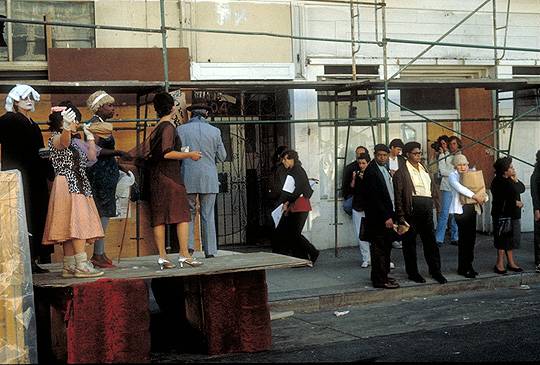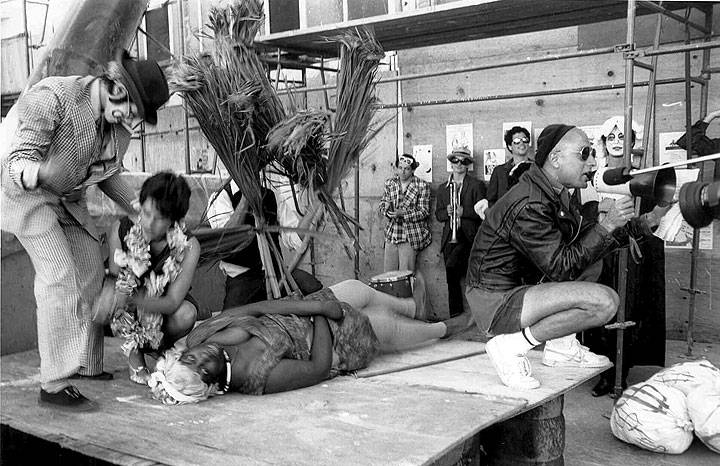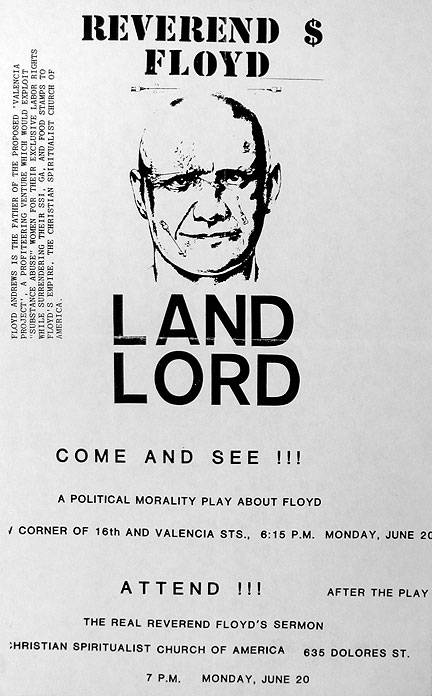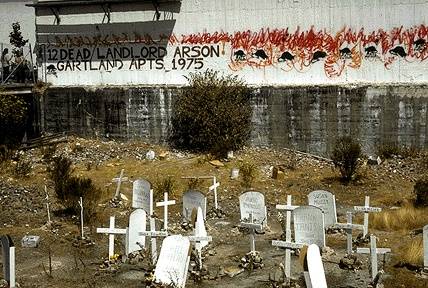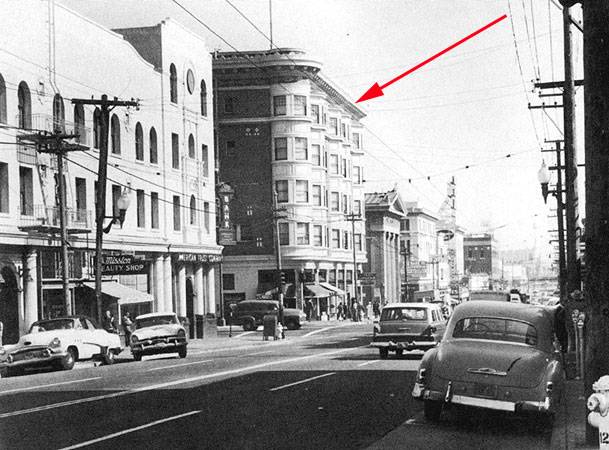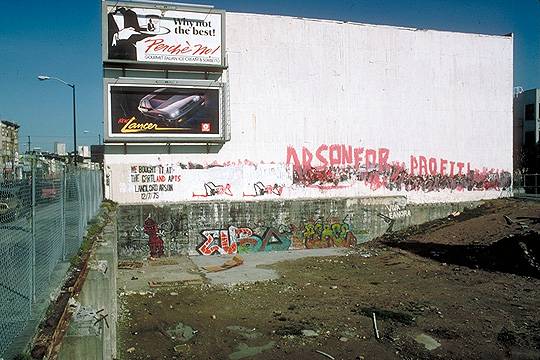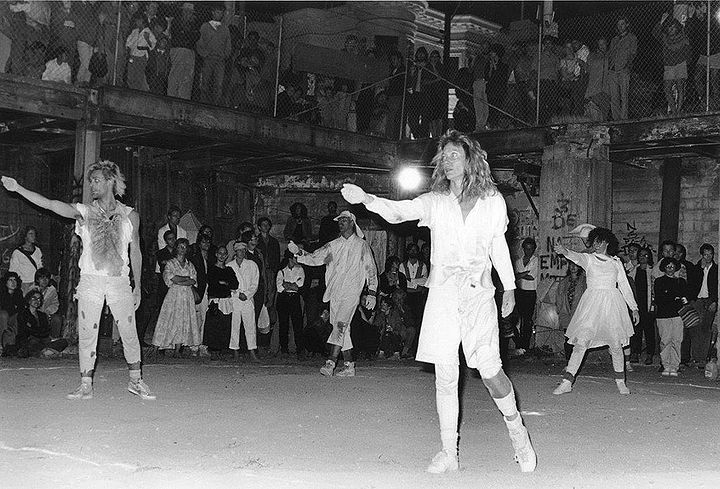Urban Rats: Difference between revisions
(added Jeanne Hansen photo and fixed audio link) |
(added Jeanne Hansen photo and fixed audio link) |
||
| Line 75: | Line 75: | ||
''Photo: © Jeanne Hansen'' | ''Photo: © Jeanne Hansen'' | ||
<iframe src="https://archive.org/embed/GartlandPitAndAftermathSept.261987" width="500" height=" | <iframe src="https://archive.org/embed/GartlandPitAndAftermathSept.261987" width="500" height="30" frameborder="0" webkitallowfullscreen="true" mozallowfullscreen="true" allowfullscreen></iframe> | ||
'''42 minutes of sound from a live punk concert in the Gartland Pit, Sept. 26, 1987, featuring Tom Jennings and Shred of Dignity''' | '''42 minutes of sound from a live punk concert in the Gartland Pit, Sept. 26, 1987, featuring Tom Jennings and Shred of Dignity''' | ||
Revision as of 13:42, 6 August 2015
Unfinished History
Urban Rats on "stage" at 16th and Valencia, the "garden of decay," in the early 1980s.
Photo: Susan Greene
Urban Rats protesting Reverend Floyd at 16th and Valencia, June 20, 1983.
Photo: Susan Greene
Urban Rats, a San Francisco political agit-prop group in the early 1980s, carried on an active campaign over the "Gartland Pit," targeting especially the Reverend Floyd Andrews, a shyster preacher running the Christian Spiritualist Church of America at 635 Dolores St. He had plans to "develop" the site as a home for women with drug problems (who would then work for the Reverend's church, while turning over their various support payments to him).
Tales of the Urban Rats, circa 1982
The Urban Rats was a short lived, loosely knit San Francisco based collective of young artists, students, filmmakers, musicians, and political activists trying to figure out how to make politically relevant and engaged urban street art. We were very taken with our discoveries of The Situationists, The Yippies, The Cuban Cine-Movil and other experiments in bringing art out of the galleries and into the streets.
These short remembrances of our activities are by three of the members of the group a give a sense of the spirit of that moment and the creative fun that was had!
--Jeffrey Skoller, Susan Greene, Peter Plate, 2001
Jeffrey Skoller: It was all billboard alteration to us. Some billboards were the regular 2-D kind, some were 3-D that could move, some were sonic and some billboards were live bodies in the street! We used Guerrilla theatre, made nocturnal billboard alterations, posters, placards, effigies, parade floats, super 8 films projected on the sides of buildings; there were musical parades with trumpets, saxes, garbage cans, voices! We were young artists, filmmakers, writers, and students from all media trying to find ways to break out of the formalist and abstract art traditions we were studying in school. Reagan was on the move: military build up, CIA drug cartels destroying liberation struggles all over the world. We wanted to find ways of making art that was engaged. We were loud and ugly and we tried to be heard over the din of Reaganist jingoism. IT HAD BEEN SO QUIET SINCE THE END OF THE VIETNAM WAR. The Dead Kennedys and Sex Pistols made things louder. The Urban Rats were guerrilla artists. HAIG=MASS MURDER! On any given night we would have half the Salvadoran refuges who were hiding in San Francisco down in our workshop/loft--an old bar once called the Russians--making placards and signs protesting the US supported dictator of the week or government official who came to town schilling for corporate money. Those painting and banner parties became underground classrooms where middle class art students got to practice their Spanish and Marx talking for hours to the Latin American refuges who had experienced more real-politic in a month than any of us had in 20 years of schooling. We grew, we helped them. The Rats became part of the cultural wing of the local SF movement for a while. We weren't just painting nice murals on city sanctioned walls. We made billboards for demonstrations out of anything we could find: The cops tore down a shack in which some homeless used to stay, so we used the wood to build a huge 8 foot Trojan wooden fist on wheels and rolled it from the hotel where police were beating marchers who were protesting the arrival of Reagan's Salvadoran henchman Duarte. We took that Trojan fist, marched across town to city hall and rolled up to Feinstein's door screaming Stop Killer Cops! When President Reagan and the Queen of England had dinner in Golden Gate Park the Rats built 20 ft effigies of those hideous creatures mounted on top of huge MX missals! Though the FBI wouldn't let us within a mile of the park, hundreds of people gathered around those effigies, which became the focal point that night for protesting the military build up in Central America, the British intervention in the Malvinas.
Other nights we made our own billboards which we pasted outside the Russians (an old bar converted into live/work space and ground control for the Rats) on 6th near Mission Street. Across town a couple of filmmaker Rats influenced by the early "Cuban Cine-movil" (where the Cuban filmmakers brought their films to the peasants on horseback) were showing revolutionary films in some of the punk rock clubs, underground galleries and on alleyway walls! We saw that projected films were billboards too, and thought by showing our films in alternative spaces and on the streets we were altering those Hollywood billboards at the multiplexes. Anarchism in America played to sold out shows at the Valencia Tool and Die. The following week it was Godard's Sympathy for the Devil at ARE Gallery. Afterwards people endlessly talked with each other about the films or argued with the sectarian RCP dudes leafleting outside the club.
The Urban Rats saw everything as a potential billboard. As political catalysts using our skills and knowledge as artists, we were trying to capture back some of the public space taken from us by ubiquitous corporate advertising. We were trying to make a wedge into the public sphere for other ideas to be seen and hear. So we used all means available to us. But this was a long time ago. Way before silicone valley took over every corner of San Francisco, and put a computer in every kids house to keep him off the street alone, isolated and afraid...If the Urban Rats were still around today, their motto would be " YOUR MIND IS A BILLBOARD, ALTER IT!!"
Susan Greene and Peter Plate: A trail of tears, devolution along the Valencia Corridor. We were a loose amalgamation of artists and activists who recognized the climate of gentrification we were living in. It was a war between real estate speculators, slum landlords and tenants. We fired the opening salvo at 16th and Valencia, the site of the Gartland Apartments landlord arson fire.
In mid ’70s, the Bay Area Rapid Transit System or BART was completed with its key stations constructed in the transitional neighborhood of the Mission. The Mission was a working class enclave that had withstood the onslaught of gentrification. It was a neighborhood that traditionally had been a home to political exiles, immigrants and refugees from around the world. The completion of the BART system signaled a rise in property values and foretold the future of the district. The Mission would become a high priced neighborhood for young middle class professionals. In the years immediately after BART's completion a series of landlord arson fires were set. It is much easier to speculate property that does not include a rundown building filled with poverty stricken tenants. The Gartland Apartments at the corner of 16th Street and Valencia was set on fire in December of 1975. 25 people were caught inside because the fire escapes had been wired shut. 13 bodies were never found. Several people spoke to us during the installation of the Pit, who said that they had known people who perished in that fire. The Pit was agit prop and a memorial honoring the victims of the Gartland Landlord arson. The grave yard and text that the Urban Rats erected remained untouched for months. It was destroyed the morning after the late Thomas Albright, art critic at the Examiner, wrote a review of The Pit installation, calling it the "best Mission Mural." That was too much attention for the slumlord who sent two young men to destroy it. A couple of guys from the bar/nightclub Esta Noche tried unsuccessfully to defend The Pit. They told us about it later when we went to survey to damage. The Pit lived on however. Between the spring of 1983 and summer of 1987, repeated site projects were enacted at The Pit. The Pit was de-territorialized and removed from the definition of private property as we know it. It became a public vector, the site of poetry readings, dance performances, film screenings. In the autumn of 1987, ground was broken for the Maria Alicia Apartments, a low income housing project. Today landlord arson fires are occurring again in the Mission. This is history repeating itself. In the ’70s and ’80s we saw the beginning skirmishes of a real estate war. Now we are living in the midst of spatial and class apartheid.
Photo: Susan Greene
Gartland Apartments at Valencia and 16th Streets, 1958.
Photo: San Francisco History Center, San Francisco Public Library
Susan Greene: This was some of the most satisfying and exciting work I have ever done, art and politics, activism, the immediacy, life-art, the engagement with all kinds of people, the late night early morning illicit thrill of using big business‚s words, images and space, and turning them around so they became the object of scrutiny and analysis. We worked with what the environment had to offer, and manipulated existing signs to say what we wanted to say, something large, public and illegal. We turned that light on ourselves too. Many of our group were middle class, white artists, activists and intellectuals, and were thus, in spite of ourselves, part of the first cutting edges of the gentrification of the Mission. Everyone knows that murals also raise property values. Now most of us can barely afford to live in San Francisco, and cannot afford to live in the Mission.
We found that working at rush hour or on a busy Saturday afternoon worked well. We would dress in painter‚s overalls and just acted like we had a right to be doing what we were doing. No one noticed anything until it was all over. The other good time was 3-4 am, when the city was sleeping...bars were closed, the light was dark green and gray, there weren't many cops out then, and we were just shadows flitting around loaded with spray paint, rolls of paper, wall paper paste and so much passion, so much to say. Climbing up onto narrow ledges, lookouts on the corner with their special whistles well rehearsed, we worked fast and faded into what remained of the night. We worked together, and at times it felt like we operated like a well oiled machine. We trusted each other and some of us have become life long friends. We looked out for each other... of course there was the time when several of us were arrested, having had the bad luck of choosing a stake-out site for a bill board alteration. Three of the Urban Rats went to jail for the weekend. The cops were so mad that their stake-out had been ruined that they exaggerated the damage making the bail exorbitantly high. The fellows decided to get out on their own recognizance which meant a week-end in jail. When fellow inmates heard what the Rats were in for, they said in surprise "...and you didn't get paid for that shit? That's white boy crimes..."
We waged a campaign against Mayor Finestein, or Fine/swine, or Frankenstein’s legacy in the real estate development in San Francisco. The Gray Panthers tried to get her recalled. We matched the font of her campaign and put Re-elect Mayor Frankenstein on her campaign headquarters. We added our own campaign poster that pictured her with a Bride of Frankenstein hair-do. Herb Caen wrote that our contributions were "The most interesting thing about an otherwise dull campaign."
The City waged a media blitz against people sneaking onto Muni busses. "No fare is no fair" their ads said, the "bad and now humiliated and shamed person who snuck on the bus is surrounded by the morally superior passengers." We changed that to "Fare is no fair" and made the recalcitrant passenger into our fair Mayor, the aforementioned Finestein.
The Reverend Jones, who owned a church with which he attained tax exempt status for his heinous business efforts, which had mostly to do with taking the welfare checks of women with drug and alcohol problems in exchange for room, board and slave labor. He wanted to start a factory on the corner of 16th and Valencia. We put up posters and staged a passion play, "The Life and Crimes of the Reverend Jones." We gathered a group of 75 people and marched to the church. We did not gain entry but his sweat shop proposal did not get approval.
Many more billboards: "America is going towards Europe", featuring Uncle Sam became "America is going towards Fascism"; Marlboro Men, and tough guys smoking Camels were beheaded. We became the Domino Theory for Carnival, dressed up in sandwich board dominoes. We were met with cheers by the onlookers. One of our crew wore a Reagan mask and was assaulted by the white domino dots that we pulled off and threw. We turned billboards for "Skyline Realty" into "Slumlord Realty." Early one morning we took a photo of a prominent slumlord as he left his mistress's house. The next day the neighborhood was plastered with the guy's mug and "Wanted for felonies" with a listing of his grievous offenses. One night we staged a macabre cocktail party outside said realtor’s office. We aspired to a kind of cultural War of the Flea.
{{#ev:archive|ssfGARTPIT1|320}}
URBAN RATS performance at 16th and Valencia
The infamous Gartland Pit, what was left after arson killed a number of tenants and led to the demolition of the residential hotel.
Photo: Susan Greene
Contraband performs Religare in the Gartland Pit, early 1980s.
Photo: © Jeanne Hansen
<iframe src="https://archive.org/embed/GartlandPitAndAftermathSept.261987" width="500" height="30" frameborder="0" webkitallowfullscreen="true" mozallowfullscreen="true" allowfullscreen></iframe>
42 minutes of sound from a live punk concert in the Gartland Pit, Sept. 26, 1987, featuring Tom Jennings and Shred of Dignity

